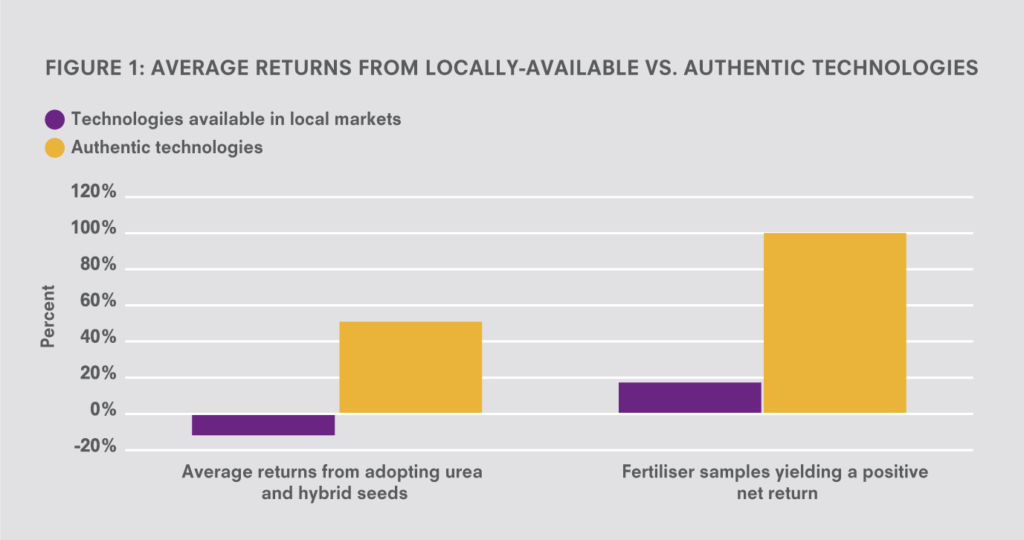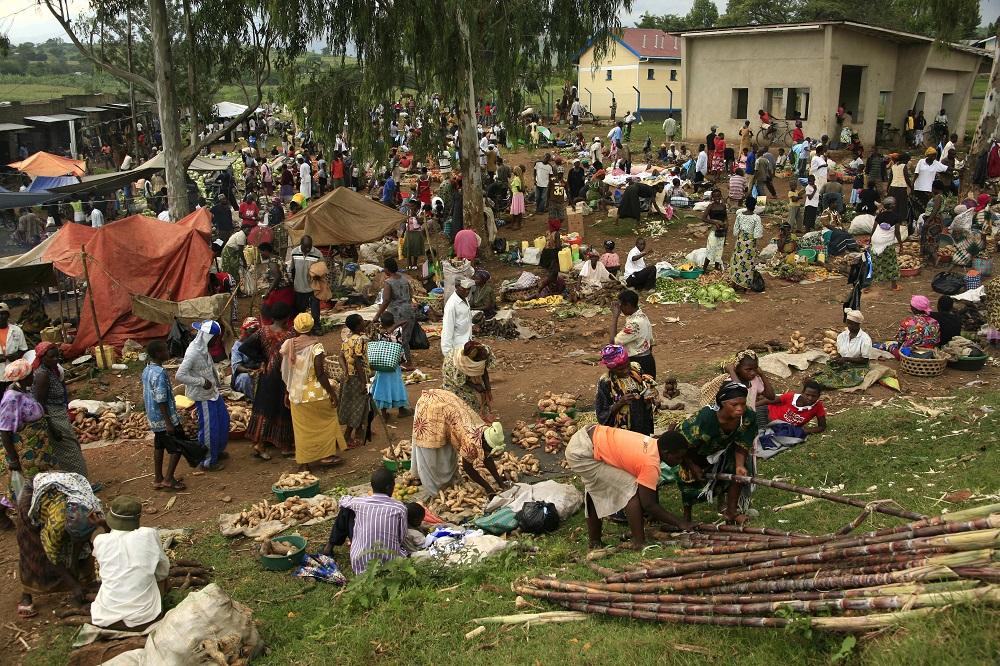
Seeding success: Increasing agricultural technology adoption through information
Modern agricultural technologies have enormous potential to drive poverty reduction and economic growth, but adoption remains low in many countries. New models of information sharing could help resolve this.
-
IGCJ5833-Agriculture-growth-brief-171214-Web.pdf
PDF document • 3.68 MB
Introduction
With over half of working adults in sub-Saharan Africa employed in agriculture, improving agricultural productivity is an important way to raise living standards. This brief focuses on mechanisms to encourage the adoption of better farming technologies – broadly defined to include improved agricultural practices, inputs, crop varieties, and other products like crop insurance or innovative lending products – to increase agricultural productivity and improve livelihoods.
While numerous studies and field trials have demonstrated large potential productivity gains from agricultural technologies such as hybrid seeds and fertiliser, their usage remains strikingly low in Africa. The rates of fertiliser use in sub-Saharan Africa are one-eighth the worldwide average, with Africa accounting for only 3% of global fertiliser consumption in 2013 (FAO, 2015).
Key messages
- Information barriers can prevent the uptake of agricultural technologies.
Farmers need to be aware of a technology’s existence, its benefits, and how to use it effectively – and they may need to overcome behavioural barriers that can create resistance. - The risk of poor quality agricultural inputs poses a major barrier to technology adoption as input quality is often hard for farmers to detect.
A lack of information on input quality is particularly problematic when low quality inputs are prevalent on the market. It is important for policy to address supply-side barriers like poor input quality alongside demand- side challenges. - Information and communication technologies can play a key role in supporting knowledge sharing.
Innovative applications of technologies, such as mobile agricultural information platforms to improve agricultural supply chains and extension services, have the potential to increase the cost-effectiveness and impact of information for farmers.
Key message 1 – Information barriers can prevent the uptake of agricultural technologies.
Farmers make multiple decisions in the agricultural cycle about the adoption of products and practices. Research has identified that throughout this cycle, a number of informational challenges can hinder agricultural technology adoption. First of all, for adoption to occur, farmers need to know that a technology exists, believe that it will improve productivity, and understand how to use it effectively.1
Donors, governments, non-governmental organisations (NGOs), and other institutions have made significant investments over the past few decades in programmes and campaigns aimed at disseminating agricultural information to farmers. However, the traditional models used to spread advice to farmers, such as agricultural extension services, are expensive and often ineffective. At the same time, there is great potential for improved models of agriculture extension and information-sharing to help build agricultural productivity, including innovative solutions using mobile technologies.
Emerging research suggests a number of strategies to strengthen the effectiveness of information provision as a tool to facilitate technology adoption:
- Information should be accurate and tailored to individual farmers: It is important for farmers to be provided with reliable advice about appropriate technology solutions specific to their situation. This includes considering how the crops, weather conditions, market prices, and other aspects of the local context may affect the profitability of a technology. New systems using satellite weather data and market price data have promise for delivering information and advice specific to local needs (Biffis and Chavez, 2017).
- Information providers should be rewarded for success: Trainers should be incentivised to effectively disseminate information; feedback and rewards for reaching goals can help to motivate better performance (BenYishay and Mobarak, 2014; Jones and Kondylis, 2015). In cases where information can be considered a ‘public good’, the public sector may be best placed to disseminate it. In other cases, the private sector may be better placed with natural incentives to provide information and marketing on new agricultural technologies.
- Information provision interventions should focus on overcoming behavioural biases: Training and information can be particularly useful in cases where behavioural barriers prevent farmers from reaping the benefits of new agricultural practices or technologies (Duflo, 2011). Psychological blockages may include procrastination, forgetfulness, lack of self-control, or risk aversion.
- Information should come from credible sources: Farmers may be more likely to follow agricultural advice when it comes from multiple people within their social network or from people like themselves, according to research in Malawi and Kenya (BenYishay and Mobarak, 2014; Beaman et al. 2015; Tjernstrom, 2015). Individuals who are well-connected and respected within the community may be good candidates to engage as trainers or agents promoting improved agricultural inputs.
- Information should be new: Training efforts should focus on information farmers are unlikely to figure out on their own, such as new crops, new technologies, or other difficult-to-observe lessons (Cole and Fernando, 2016; Hanna et al., 2014). Efforts to spread information to farmers in Mozambique about the nutritional benefits of orange-fleshed sweet potatoes are one example (Jenkins et al., 2015). There is a stronger need for training when technologies are very complicated, different from the status quo, or prone to misuse.
- Information should be accessible and targeted to the right populations: Special efforts may be required to make information more accessible to certain groups such as women or the poor, who tend to face greater information access barriers. Interestingly, there is some suggestive evidence that female extension workers may be more effective in disseminating information to female farmers (World Bank, 2012). Information-sharing solutions using mobile technologies may need to address issues of inequality in mobile access and usage among different groups.
- Information must come at the right time: Information on new technologies available should ideally come at the moment when it can be most effective in changing practices. For instance, a recent study found that offering maize fertiliser to Kenyan farmers right after the harvest – when they had cash on hand – increased adoption by 11–14 percentage points relative to an intervention offering the fertiliser at planting time (Duflo, 2011). Other research has found that providing timely agricultural information via mobile phones can help to change farmers’ behaviours and increase yields (Cole and Fernando, 2016 – see box on next page).
This brief focuses on informational barriers that can inhibit agricultural technology adoption. Numerous other barriers to agriculture technology adoption are not covered in this brief, including inefficiencies in the markets for land, labour, credit, and insurance (Jack, 2013). An important caveat here is that while information is an important part of the solution, it alone may be insufficient to improve farmer livelihoods in the face of other obstacles like high transport costs or credit constraints. Evidence comparing the relative importance of each of these barriers is limited and there is a need for further research across barriers.
SMS advice for farmers in India
Recent research in India tested the impacts of a mobile-phone based service that provided cotton farmers with access to agricultural consulting via a toll-free hotline and sent weekly agricultural information on weather and crop conditions via an automated voice message.
The study revealed a high demand for agricultural advice services, with 80% of the farmers calling the hotline within the two-year period of the study. The average farmer made 20 calls and used the service for over 2.5 hours. Farmers with access to the service were more likely to adopt practices and agricultural inputs recommended by the service, including higher-value cash crops and more effective and less harmful pesticides, and achieved higher yields.
It also revealed evidence of a “digital divide” in India with systematic differences in adoption and use of the service, including lower usage by poorer, less education farmers, even though it was designed to be accessible to an illiterate population.
Surprisingly, although it was estimated that each dollar spent on the service yielded a $10 return, farmers’ willingness to pay for the service was low, at roughly $2 for a 9-month subscription that costs $7 to provide, suggesting a potential role for subsidies to promote technology adoption (Cole and Fernando, 2016).

Farmer in India. Photo: Getty | Adrian Pope
Key message 2 – The risk of poor quality agricultural inputs poses a major barrier to technology adoption as input quality is often hard for farmers to detect.
A major barrier to agricultural technology adoption in sub-Saharan Africa is the low quality of many agricultural inputs – coupled with a lack of reliable information on input quality. Demonstration plots across Africa have shown that modern agricultural inputs like improved seeds and fertiliser have the potential to improve yields. However, in practice, the prevalence of poor-quality or counterfeit seeds and other inputs in the market can make it inadvisable for small-scale farmers to take the risk of purchasing inputs that promise higher yields. Instead, for example, farmers rely on seeds from their own harvest, resulting in substantially lower yields. Information gaps play a critical role in these input market inefficiencies.
Research supported by the IGC and the Swedish Research Council shows that farmers may be wise not to invest in some inputs, given widespread poor product quality. A recent study in Uganda, where only 2% of smallholder farmers use inorganic fertiliser, found that the vast majority of fertiliser available is of substandard quality. Additionally, the study uncovered evidence that very few of the available hybrid maize seeds improved crop yields, likely due to ‘fake’ or poor-quality inputs. Farmers often complain about low quality fertiliser and seeds and this study helped quantify the size of the problem beyond anecdotal evidence.
A recent study in Uganda, where only 2% of smallholder farmers use inorganic fertiliser, found that the vast majority of fertiliser available is of substandard quality.
In the study, ‘mystery shoppers’ purchased urea fertiliser and hybrid maize seeds from a number of randomly chosen small outlets across Uganda. First, to test the quality of the seeds, test plots were grown. Based on the yields, the researchers concluded that the hybrid seed bags bought from local retailers seemed to be diluted with only half the seeds being hybrid (the other half were traditional seeds). Second, to test the quality of the fertiliser, samples were sent to a laboratory to determine its chemical composition. Urea fertiliser – the most common type on the market – was found to have 33% less nitrogen content than advertised. There was wide variation in the results, but only 20% of fertiliser samples bought locally were profitable when applied to hybrid seeds and only 1% yielded a return of over 10%. By contrast, authentic inputs would have yielded average returns above 50%.
Figure 1: Average returns from locally-available vs. authentic technologies

The results provide a compelling explanation for low adoption of these agricultural technologies in the Ugandan context – farmers choosing to spend money on the fertiliser or hybrid seeds would in fact receive a negative return on their investments in most cases. The experiment surprisingly found no relationship between fertiliser price and quality, indicating a lack of reliable information on quality. An earlier study in Kenya found that even without product quality problems, official recommendations of how to use inputs can be incorrect or insufficient; the package of fertiliser and hybrid seeds recommended by the Ministry of Agriculture was not profitable for most farmers in the country (Duflo et al., 2008).
These findings highlight the need for better quality information about the appropriate use of inputs, and improved monitoring and enforcement of agricultural input standards. Further work is needed to identify where quality deterioration happens along supply chains – whether during the initial production process or later through poor storage or counterfeiting – and how it can be stopped. It may take time to restore farmers’ trust that agricultural products and technologies meet quality standards, whether through the establishment of more reputable brands or more reliable and transparent ways of testing quality.
Finally, it is worth noting that many parallel challenges exist in ensuring food safety on the consumer side. Consumers are unable to observe many important quality and safety characteristics when purchasing food, similar to the challenge that farmers face when they buy inputs. Inadequate crop and food regulation can have adverse effects on consumers by allowing food with toxins or insufficient micronutrients to enter markets. Recent research shows that consumers value information on food origin, taste, and safety and such information can help resolve market failures and inefficiencies (Hoffmann, 2014).
Much of the recent research on agricultural technology adoption assumes that quality inputs are available and focuses instead on demand-side barriers to uptake. However, supply-side challenges, including the availability of the technology in the first place, should not be ignored. Better information, whether about product quality or about agricultural practices, has a key role to play in addressing both these challenges.

Market in Uganda. Photo: Getty | Jeremy Jowell
Key message 3 – Information and communication technologies can play a key role in supporting knowledge sharing.
Over the past decade, information and communications technologies (ICT) have become a feature of many African farmers’ lives. These technologies have the potential to help improve agricultural technology adoption. Information sharing through ICT can inform farmers about new technologies and market conditions, such as prices, to help them decide when and where to sell their harvests (Aker 2010).
The impact of traditional government extension services such as farmer field schools, train and visit models, and test plots has been mixed, and these services can be ineffective if they promote technologies that are not profitable (Duflo et al., 2008). Surveys show that less than 6% of farmers in India report having used information from these services, although they consume significant budgetary resources (Glendenning et al., 2010). Studies of extension practices to encourage fertiliser use in Kenya, hybrid rice adoption in Sierra Leone, and coffee growing practices in Rwanda were found to have high costs and mixed impacts (Duflo et al. 2008; Glennerster and Suri, 2017; Duflo and Suri, 2010). The effectiveness of public extension systems is often hindered by issues including the top-down approach and inefficient management practices.
Innovative approaches to reducing the informational barriers to agricultural technology adoption include mobile information platforms and farmer helplines to deliver information on agricultural practices, commodity prices, and weather forecasts through text- and voice-based services (GSMA, 2017). ICT solutions can also deliver information on pests or diseases control, ideal times to plant crops, and information on subsidies or other programmes available to farmers.
Many different products and business models are under development and research findings on the impacts of some of these agriculture training and information-sharing solutions are beginning to emerge. For instance, a study in Kenya found that sending SMS messages to sugarcane farmers with agricultural advice increased yields by 11.5% (Casaburi et al., 2014). In India, a recent study found positive impacts from a mobile-phone based agricultural consulting service providing information on weather and crop conditions. In rural Pakistan, a platform sharing crowdsourced information on the success of veterinarians in artificially inseminating livestock led to service improvements (see box below).
For instance, a study in Kenya found that sending SMS messages to sugarcane farmers with agricultural advice increased yields by 11.5%.
Developing and scaling up these alternatives to traditional agricultural extension may require collaboration across the public and private sectors. The public sector has a role in making agricultural information less costly to acquire or distribute, and helping to bring agricultural technologies to scale. At the same time, the private sector might be more effective in developing strategies to market and disseminate information to smallholders – although there may not be sufficient profit incentives to reach the poorest farmers. Mobile agricultural services often require users to pay monthly subscription fees, which may exclude the poorest farmers. Innovation around financially sustainable and inclusive business models will increase the reach and impact of these solutions.
Crowdsourcing to share information on livestock insemination
In rural Pakistan, IGC supported the pilot-testing of an innovative approach to sharing information on the success of veterinarians in artificially inseminating livestock. Similar to the way that information clearinghouses, such as Amazon, eBay, and Yelp, rely on user ratings about products and services received, the system required farmers to report whether the insemination had succeeded. The crowdsourced rating system motivated veterinarians to perform better with 27% higher success rates, and in turn farmers were more likely to return to them for future services, suggesting that the system helped to strengthen government accountability (Rezaee et al., 2015).
Policy recommendations
Information and knowledge play an important role in the uptake of technologies to boost agricultural productivity. While information on its own is not a panacea, information can help farmers make better decisions about what agricultural inputs and practices to adopt and it can give them more bargaining power in their interactions with buyers. Particularly when combined with efforts to address other key bottlenecks to productivity, information has a potentially transformative role to play.
Some of the lessons and ideas from this brief are synthesised in the following list of recommendations for policymakers:
- Solutions need to start by understanding farmers’ needs and perspectives. The specific barriers to technology take-up in a given context need to be well-understood before policy solutions can be designed. This includes understanding, for instance, whether the primary binding constraint is a lack of information about agricultural technologies or poor quality inputs and technologies.
- Tackling poor quality and counterfeit agricultural inputs like fertilisers and seeds should be prioritised. A starting point is to replicate research like the Uganda study described in this brief in other contexts to illuminate the extent of the poor quality inputs problem. Similarly, research and monitoring to detect food quality and toxin contamination is important for consumer food safety (Hoffmann 2014). Long-term strategies such as building seed certification systems and establishing credible product brands to improve input quality are needed.
- New ICT-based approaches to sharing agricultural information could replace or complement less effective traditional agricultural extension programmes. While there is still a need to prove the impacts of different approaches, mobile-based agricultural information platforms and consulting services are starting to demonstrate their potential to deliver information to farmers about new technologies, weather forecasts, and market conditions at lower cost and with more customized information than traditional extension services. Key challenges include building sustainable business models, effectively leveraging social networks, and exploring ways that machine learning and crowd- sourced data on farmers’ experiences can be used to generate better agricultural advice.
- Information-based solutions may require special strategies to ensure that vulnerable groups such as women and the poor are reached. Agricultural extension efforts often tend to reach better-off farmers despite their goals of reaching the poor. Information-based solutions have the potential to break down access barriers but the risk of deepening inequalities must also be mitigated.
- Innovative models of collaboration across the public and private sectors deserve further testing. Innovative funding and delivery models may involve cooperation across the public and private sectors to support agricultural technology adoption, taking advantage of the comparative strengths of each. ‘Smart’ subsidy models that can help build access to modern agricultural training and mobile-based information services may have some potential, for example.
- Focus on behavioural biases that inhibit technology adoption. Simple strategies to overcome psychological blockages like procrastination, forgetfulness, and risk aversion may have surprising impacts. Timing matters – encouraging farmers to invest in inputs is likely to be more effective right after harvest time when they are least credit-constrained, for example.

Banana farm in Uganda. Photo: Getty | Nigel Pavitt
References
Aker, J. (2010). Dial ‘A’ for Agriculture: Using Information and Communication Technologies for Agricultural Extension in Developing Countries. Tuft University, Economics Department and Fletcher School.
Beaman, L. et al. (2015). Can Network Theory-based Targeting Increase Technology Adoption?. Northwestern University.
BenYishay, A., Jones, M., Kondylis, F., and Mobarak, A. M. (2015). Are Gender Differences in Performance Innate or Socially Mediated?. Working Paper.
BenYishay, A. and Mobarak, M. (2014). Social Learning and Communication. National Bureau of Economic Research Working Paper No. 20139.
Biffis, E. and Chavez, E. (2017), Satellite Data and Machine Learning for Weather Risk Management and Food Security. Risk Analysis.
Bold, T., Kaizzi, K. C., Svensson, J., & Yanagizawa-Drott, D. (2017). Lemon Technologies and Adoption: Measurement, Theory and Evidence from Agricultural Markets in Uganda. The Quarterly Journal of Economics.
Casaburi, L. et al. (2014). Harnessing ICT to Increase Agricultural Production: Evidence from Kenya.
Cole, S. and Fernando, N. (2016). Mobile’izing Agricultural Advice: Technology Adoption, Diffusion and Sustainability. Working Paper 13–047, Harvard Business School.
Duflo, E., Kremer, M. and Robinson, J. (2008). How High Are Rates of Return to Fertilizer? Evidence from Field Experiments in Kenya. American Economic Review, Volume 98, No. 2.
Duflo, E., Kremer, M. and Robinson, J. (2011). Nudging Farmers to Use Fertilizer: Theory and Experimental Evidence from Kenya. American Economic Review, Volume 101, No. 6.
Duflo, E. and Suri, T. (2010). Diffusion of Technologies within Social Networks: Evidence from a Coffee Training Program in Rwanda. International Growth Centre Working Paper.
FAO (2015). FAO Statistical Pocketbook 2015. Food and Agriculture Organisation of the United Nations, Rome.
Glendenning, C. et al. (2010). Review of Agricultural Extension in India: Are Farmers’ Information Needs Being Met?. The International Food Policy Research Institute (IFPRI) Eastern and Southern Africa Regional Office Discussion Paper.
Glennerster, R. and Suri, T. (2017). The Impact of New Rice Varieties on Health in Sierra Leone. Agricultural Technology Adoption Initiative, J-PAL.
GSMA (2017). Creating scalable, engaging mobile solutions for agriculture: A study of six content services in the mNutrition Initiative portfolio.
Hanna, R., Mullainathan, S. and Schwartzstein, J. (2012). Learning through noticing: theory and experimental evidence in farming. National Bureau of Economic Research Working Paper 18401.
Hoffmann, V., & Gatobu, K. M. (2014). Growing their own: Unobservable quality and the value of self-provisioning. Journal of Development Economics, 106, 168–178.
Jack, K. (2013). Market inefficiencies and the adoption of agricultural technologies in developing countries. Agricultural Technology Adoption Initiative, J-PAL (MIT) – CEGA (Berkeley).
Jenkins, M., Byker Shanks, C., & Houghtaling, B. (2015). Orange-fleshed sweet potato: successes and remaining challenges of the introduction of a nutritionally superior staple crop in Mozambique. Food and nutrition bulletin, 36(3), 327–353.
J-PAL/ATAI/CEGA. Agricultural Technology Adoption Initiative Policy Insights: Evidence-based insights on agricultural technology adoption in the developing world.
Rezaee et al. (2015). Crowdsourcing Government Accountability Experimental Evidence from Pakistan. International Growth Centre Working Paper.
Suri, T. (2011). Selection and comparative advantage in technology adoption. Econometrica, 79(1), 159–209.
Tjernstrom, E. (2015). Signals, Similarity and Seeds: Social Learning in the Presence of Imperfect Information and Heterogeneity. University of Wisconsin, Madison.
World Bank (2012). Toward Gender Equality in East Asia and the Pacific: A Companion to the World Development Report. Washington, DC.
Citation
Jack, K. and Tobias, J. (2017). Seeding success: Increasing agricultural technology adoption through information. IGC Growth Brief Series 012. London: International Growth Centre.



